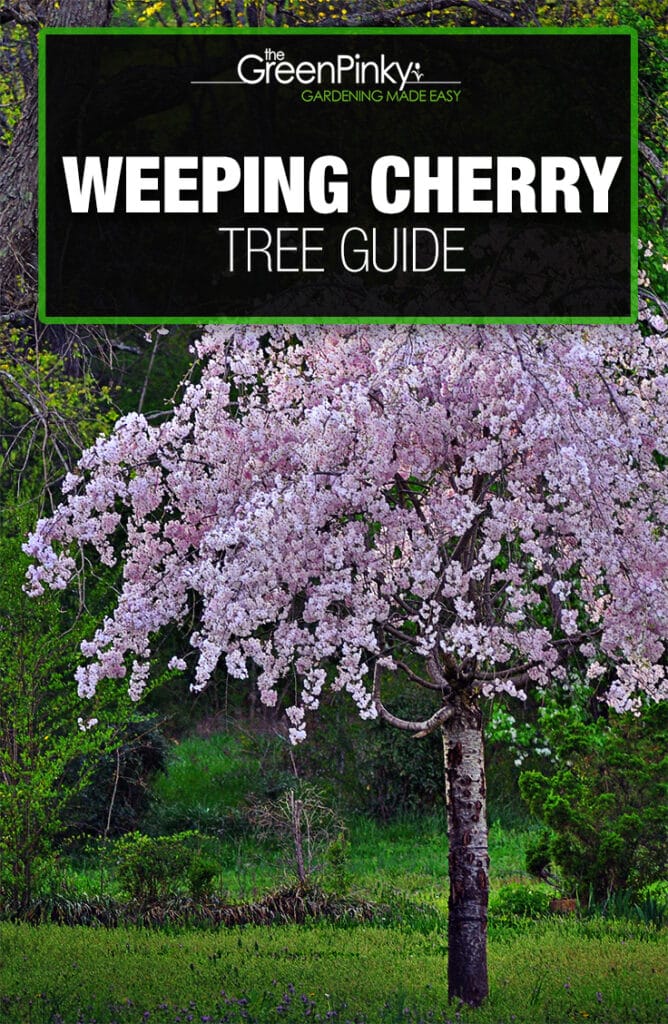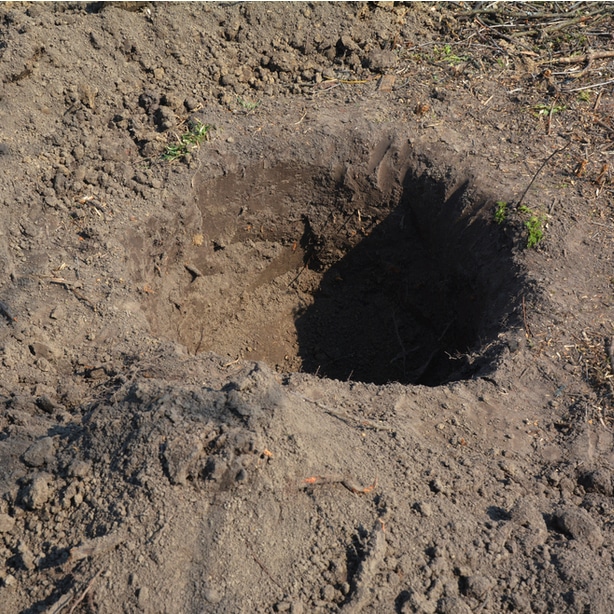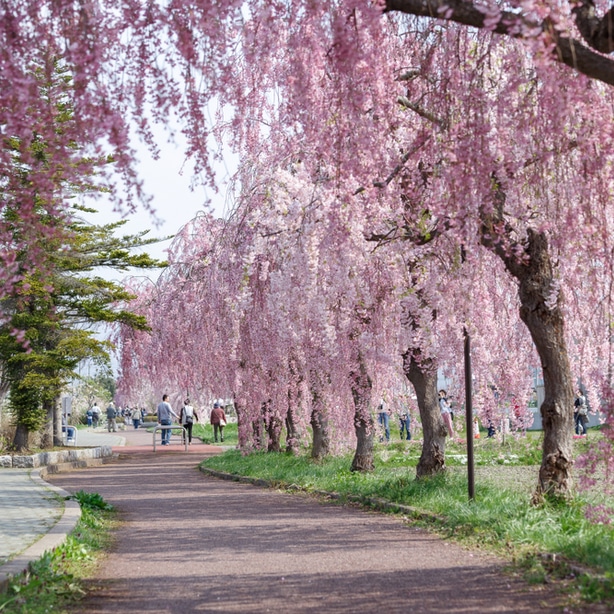A weeping cherry in bloom is a magnificent sight to behold. In spring, the canopy and cascading, arching branches are like a cloud of pastel pink or white as they fill with flowers. It is a graceful tree that is sure to grab everyone’s attention.
This particular type of ornamental cherry tree is an excellent choice for anyone who wants to add color to their property. It is a perfect complement to any landscape.
Continue reading to learn all the details about the species and find out how to care for it. You won’t regret it. On the contrary, you—and anyone who sees this stunning addition—will be sure to fall in love with this snowing and flowing, cascading beauty.
If you need to remove your tree for any reason and are unable to use a grinder, consider learning about how to rot out a tree stump.

General Information
Weeping cherries are part of the family Rosaceae, in the genus Prunus. Although native to China, the tree is a highly prized and popular aspect of Japanese culture. In fact, the cherry blossom has held the honor of being Japan’s national flower for centuries.
The tree can be grown anywhere in zones 5 to 8. Most varieties obtain a mature height of 20 to 25 feet with a spread of 15 to 20 feet. However, dwarf cultivars grow only around 10 feet tall, with a width of about 12 feet. This makes it a perfect addition to smaller landscapes.
It develops an upright and spreading habit with thin, cascading branches that easily touch the ground. This creates an optical umbrella effect.
Although some varieties bloom in late winter, most bloom in early spring. Then, the delicate branches fill with a mass of pink or white flowers that are spectacular to behold.
But even when the tree is not in bloom, it adds great color to your landscape. The deciduous, serrated, green leaves change to fiery red, yellow, and orange hues in fall. In winter, when there are no leaves left on the branches, the shiny, coppery bark adds a touch of magic to your yard.
Before the leaves appear in early spring, umbels containing two to five flowers burst onto the scene. Depending on the type, blooms are pink or white, single or double. White flowering varieties resemble snow fountains as the cascading branches fill with attractive blooms.

Once the blooms fade in summer, small red or black fruits with a 1/3-inch diameter form along the arching branches. Although they are too sour for humans to eat, birds consider them tasty treats. This makes this woody plant a good addition to wildlife gardens.
There is one downside to these magnificent trees: They don’t have a long lifespan. They typically decline after 25 to 50 years. Proper care gives them the best chance of a long, problem-free life.
If you are an ambitious gardener, you can try to match the Brooklyn Botanical Garden. It has two of the oldest weeping cherries residing in North America. Two Higan cherry trees planted in 1921 are still thriving.
General Care Guide
It’s not difficult to care for a weeping cherry. However, this plant requires its specific needs to be met for optimal health. Any gardener has to pay attention to the light, soil, and moisture the variety of tree prefers. Good care also includes proper pruning, fertilizing, and pest and disease control. Meeting these needs guarantees a showy tree for years to come.
Amount of Sun
For most varieties, a sunny location is best. Select an area of your yard that receives around eight hours of full sun daily. This will give you the best growth and most flowers. Shady conditions will slow the growth and reduce the number of flowers the tree produces.
Soil Conditions
All weeping cherries prefer fertile and well-drained soil. Heavy, non-draining soils like straight clay retain too much water, which promotes root rot. Although this species likes moisture, it doesn’t like wet feet. If your property features heavy soil with a lack of nutrients, add organic matter to the soil before planting new trees.
You can amend soil to increase fertility and drainage with well-rotted manure or compost. Spread a 6- to 8-inch layer evenly over the planting site. Work it into the native soil to a depth of about 8 inches.

Water Needs
Although many species are relatively drought-tolerant once established, regular moisture produces the best growth. Water your plants regularly and deeply, especially during hot and dry conditions. This will produce a deeper and stronger root system.
During the growing season, water enough to keep the soil moist but not soggy. During the winter months, when the plant is dormant, cut the amount of water you provide by half.
When conditions are hot and dry, you may have to water several times weekly. Water deeply, so the roots are saturated.
Mulch
Spreading a layer of mulch under the tree has several benefits. For one, it helps reduce unwanted weed growth. Organic mulch also helps the soil retain moisture, which reduces the number of times you have to water the tree. Spread about a 3-to-4-inch layer evenly at the base of the tree. Make sure to pull it back several inches from the trunk to prevent disease.
Fertilizer Needs
Fertilize in springtime, just as the foliage starts to bud. Use a slow-release formula specific to flowering trees and shrubs. Always follow label instructions when determining how much to use. More is not better, as too much can burn the foliage.
Spread the fertilizer evenly under the canopy. Scratch it into the surface so it has contact with the soil. After you have spread the fertilizer evenly, water it in well.
Don’t spread the fertilizer up against the trunk; if you do so, you will risk burning it. If any of the product gets on the foliage, be sure to wash it off.
Alternatively, you can spread a layer of well-rotted manure for a similar effect.
Pruning
Pruning is probably one of the most misunderstood aspects of horticultural care. Since the cherry has a natural cascading form, you don’t want to do any serious trimming of the branches to shape it. The only pruning necessary is to remove diseased, damaged, or crossing branches or water sprouts. Be sure to sterilize your pruning tools before making any cuts to prevent disease.
When pruning, always cut back into a healthy section of wood. If possible, wait until the tree is done flowering before making cuts.
Pest Problems
Weeping cherries are susceptible to a host of different pests. Everything from scale, spider mites, aphids, and borers can cause infestations. You can prevent many problems with the proper care. However, quick identification and action are important to control potential pest problems. Treating the problem quickly also keeps the outbreak of an infestation to a minimum.
Many times, you can blast insects off the tree with a strong stream of water. This works well when infestations are small.
More severe pests, like scales, require more serious treatments. Check out our individual pest guides to treat the issue. You may consider products such as horticultural oil. Always follow label instructions when it comes to amounts, mixing, and application. Don’t apply in the middle of the day, when conditions are extremely hot and sunny. Wait until things cool down late in the afternoon.
Insecticidal soap works well to control insects like aphids and spider mites. Once again, always follow directions on the label concerning mixing and frequency of application.
If borers pose a problem, prune off all damaged areas of wood. Trim them back to a healthy section of wood, using sterilized pruning tools. When you are done, treat the area with horticultural oil.
Disease Problems
Many diseases are preventable with good care and hygiene. However, you can still encounter various leaf problems, powdery mildew, and rot. These problems may require treatment. Keep the area beneath the cherry free of fallen debris. Grow in preferred soil conditions and with appropriate water. Keep the foliage dry by irrigating early in the day so it dries before nightfall.
Rot becomes a problem when conditions are too wet. This can be because the soil doesn’t drain well or because you overwater. The best way to avoid rot is to grow the tree in its preferred soil type and good drainage.
Powdery mildew is another preventable disease. Simply make sure you plant your tree in preferred conditions. Overhead watering, shady conditions, and overcrowding without good air circulation all promote mildew.
Many leaf problems are preventable with a fungicide or treatment with horticultural oil. Apply either treatment in winter while the tree is bare of foliage. Be sure to clean the area of any fallen foliage or other debris that might promote these problems.
Planting Tips
Planting correctly assures your sapling or mature transplant gets off to a good start. After selecting a location with full sun and draining soil, you’ll first need to prep the area. It’s important to clear the area of any unwanted growth. Now is also the time to amend the soil if needed. Proper planting promotes healthy growth.
Remove unwanted weed or grass growth from the planting location. Clear an area that is approximately 3 feet in diameter. This opens up a space large enough for the cherry to grow without the trunk suffering damage from lawn equipment bumping into it.
If needed, amend the native soil. Spread well-rotted manure or compost over the area and work it into the area to about 8 inches deep.
Dig a hole that is as deep as the root ball and several times wider. This loosens the area, which in turn makes it easier for the roots to establish themselves.
Place your new plant into the hole and fill it halfway with soil. Water the area to settle the soil and remove any air pockets.
Backfill the remainder of the hole, and firm up the soil around the tree’s base using your foot. Make sure you don’t plant any deeper than it was growing in its container. Planting too deep puts undue stress on the plant.
Apply several inches of organic mulch over the area. Just be sure to pull it back several inches from the trunk. This prevents possible disease problems.
Water thoroughly after planting. Irrigate deep enough to saturate the root ball.
If planting multiple cherries, be sure to allow enough space between them. Consider its mature height and spread. You need to allow proper air circulation between plants to reduce pest and disease problems.

Common Varieties
There are a wide variety of different types for you to choose from. If you cannot find one at your local garden center, you’re sure to find one through online plant dealers.
Let’s look at some of the more common varieties.
Weeping Higan (Prunus subhirtella ‘Pendula’)

This variety is considered a winter-flowering variety, as it can intermittently bloom very early in the year. The showy pinkish or creamy white flowers are semi-double. The tree matures at 30 feet tall and 25 feet wide. It prefers full sun and regular moisture. Although it is drought-tolerant once established, regular moisture is best. This variety tolerates growing in zone 4.
Weeping Fuji Cherry Tree (Prunus’ Snow Showers’)

Although it’s small in stature, this weeping cherry is big on looks. It grows anywhere from 4 to 12 feet tall and 8 feet wide. The arching branches fill with fragrant white flowers in spring. In fall, the glossy green foliage changes to vibrant hues of bronze and red. Highly ornamental, it’s the perfect addition to small gardens or patio settings. It prefers a sunny location with well-drained soil.
Weeping Yoshino Cherry Tree (Prunus x yedoensis ‘Shidare’)
This type makes a dramatic display of arching branches filled with white flower clusters in early spring. It is a fast grower that matures to 20 to 25 feet tall with a typically wider width. It works well as a showy, year-round accent tree. It’s also an excellent addition to pollinator gardens. It grows well in a sunny location and prefers fertile, well-drained soils. It doesn’t tolerate growing in unamended clay soil.
Double Pink Weeping Cherry (Prunus pendula ‘Pendula Plena Rosea’)
This is a stunning ornamental that forms an elegant silhouette of graceful drooping branches. The arrival of early springtime brings dark pink buds forming into double, pale pinkish flowers. The clusters are so heavy with flowers that they, too, appear to weep along the branches. The young leaves are bronze-colored, changing to green in late spring and red and orange in fall. The tree matures to a height of about 25 feet. It prefers fertile soils that drain well and full sun.
Landscape Design Tips
Weeping cherries are a beautiful and striking addition to any landscape. They offer the area color and interest all year long. Whether it’s spring, summer, fall, or winter, its versatile good looks have something to offer. Trees work well in a variety of garden locations. Their size makes them an attractive addition to even the smallest garden.
Regardless of your garden style, the cherry fits in well. They are eye-catching additions to Japanese or Asian gardens. The tree also works well in cottage or country gardens. Between the flowers and fruit, they also are good additions for pollinators and wildlife gardens, such as butterfly gardens.
With their fabulous flowering display, they make perfect focal points in any garden. The robust leaf colors in fall and striking bark color warms a fall and winter landscape.
For a stunning display, plant them in mass. If you have enough garden space, group multiple plants together. The magnitude of color will astound you year after year. They also accent a driveway or walkway when lined along with them, and they bring color and interest to a porch or patio area with their use.
Wherever you decide to use weeping cherries in your yard, they are sure to add a colorful appeal for years to come.





hi we had a weeping cherry but was grafted onto a different type . is this common? the weeping part died but the bottom is turning to quite the bush.
I planted my jacaranda outside last summer and it hasn’t woken up yet. I’m afraid the cold might have killed it. Is it normal for them to still be dormant?